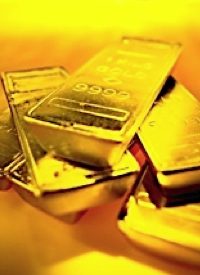
The price of one ounce of gold exceeded $1,500 yesterday, and immediately the media was filled with explanations. Jan Harvey, writing for Reuters, said gold was benefiting from “the threat of a downgrade to the United States’ triple-A credit rating this week and fresh worries over euro zone debt [that] fueled fears over the outlook for both the dollar and the euro.”
The possible termination of the Federal Reserve’s program of buying U.S. Treasuries (called Quantitative Easing, or QE2) in June adds uncertainty to the markets, and “There is still going to be a lot of uncertainty over the strength of growth in the United States,” according to Macquarie analyst Hayden Atkins. Simon Weeks, head of precious metals at the Bank of Nova Scotia, added:
Gold has been acting as a currency in its own right, and that is why we are up at $1,500. There is an awful lot of bad news in the price. The S&P comment the other day has given us the final kicker to get up here.
Others claim that it’s the weak dollar, or oil prices exceeding $100 a barrel. No one seems interested in giving a true explanation.
Reuters reviewed numerous milestones along the path to today’s gold prices, each with the “proper” explanation. In August, 1971, President Richard Nixon took the dollar off the gold standard which had been in place since the Bretton Woods Agreement of 1944. In August, 1972, the U.S. devalued the dollar by raising the price of gold to $38 an ounce, and then to $42.22 an ounce in May of 1973. When gold hit $850 an ounce in January, 1980, explanations included strong oil prices, Soviet intervention in Afghanistan, and the revolution in Iran.
Fast-forward to February, 2009 when gold hit $1,000 an ounce, which was explained as nervous “investors buy[ing] bullion as a safe store of value as major economies face[d] recession and equity markets tumble[d].” In November of last year gold pushed through $1,400 an ounce due to “weakness in the dollar” and “safe haven buying. ”
Marketwatch.com provided the most complete list of popular but extraneous and irrelevant causes, saying,
Rising political tensions across the Middle East and North Africa, uncertainty following the events of Japan, fears of higher inflation, a weaker dollar, the recent resurfacing of European sovereign debt risk, and now heightened concerns over the U.S. have outweighed the recent rate hikes to drive prices to fresh highs.
All of which makes interesting reading but misses the exquisite point altogether. As Professor Milton Freedman explained repeatedly: “inflation is always and everywhere a monetary phenomenon.” Once the last tether to gold was severed by Nixon in 1971, there was (and is) no limit to the amount of currency that can be created by the “engine of inflation,” the Federal Reserve. This is a conclusion that can be verified by going here and noting precisely the moment the dollar became unanchored from gold in 1971. The price level since that time has increased six-fold, with no end in sight.
When Ambrose Evans-Pritchard, writing in November, 2009 for the UK Telegraph, asked, “Is $6,300 [the] Fair Value for Gold?” he simply divided the U.S. monetary base by the amount of gold allegedly held by the U.S. government to arrive at that number. Anthony Wile took him to task for such a simplistic analysis: “So, Ambrose…we want you to go home today…and take a deep breath and look in the mirror. Remind yourself that inflation is the printing of money, not the appreciation of prices…”
Putting aside all the establishment rhetoric, misdirection, and persiflage for why gold is at $1,500 an ounce and moving higher, one is best served by asking instead just how much more Quantitative Easing is in store for the U.S. When will sanity rule once again and Americans realize that Voltaire was right: “Paper money eventually returns to its intrinsic value — zero.” Gold will stop its seemingly inexorable rise only when the printing press — the Federal Reserve — is shut down and real money replaces fake.



